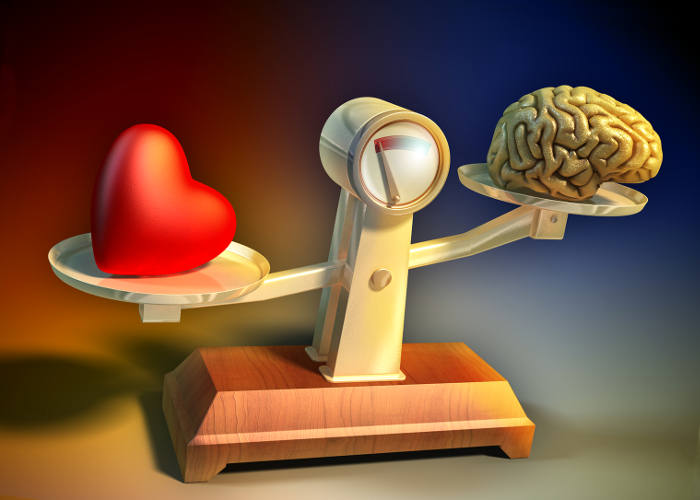You may have heard this before, but we start self-discovery with the heart.
Many traditions place great emphasis on this center in the middle of the chest. In Traditional Chinese Medicine (TCM) this is the place of Shen (精神), or Spirit. It is the “Presence”, our sense of vitality and joy. It is said that when this center is open and functioning well, the person has brightness in their eyes, strong mental health and visible well-being.
In Indian Yogic tradition this center is called “Anahata Chakra”, also located in the center of the chest, and it is associated with love, compassion, and all aspects of being truly loving within and outside of the self.
The heart produces an electromagnetic field that is much stronger than the one produced by the brain, in fact it is thousands of times stronger. This organ pulses our existence into being, showing us that life is about sound and rhythm.
But what becomes of our hearts if we spend our lives worshiping the intellect, brainpower and logical thinking? Intellect allows us to assimilate and discern, it is an indispensable tool in everyday life. It permits us to collect, interpret and apply data. Without this ability, even a spiritual master would not be able to communicate well with their surroundings, nor would they be able to pass their wisdom to others. A well developed brain and rational thinking allowed creative geniuses such as Leonardo Da Vinci, Albert Einstein and NIkola Tesla to make remarkable contributions to humanity. All of them were rational thinkers, and despite their differences they all were able to make sense of great volumes of information in their work. There is another distinctive characteristic they share. They were driven, inspired, sometimes even obsessed, but they were all “led” by an invisible force, a force that used them as vessel, a means of communication, bringing information in the form of art or scientific discoveries to humanity at large. This fiery inspiration is born in the heart, it is the force that gives us purpose and a single-pointed direction.

The world of today seems to create a separation between the left and right hemispheres of our brain, between the intellectual and the creative, and we tend to assume that one is better than the other. On the one hand we have the scientifically minded, a group that asserts that only facts and rational mind can lead humankind toward understanding the nature of reality and all phenomena. The other side believes that intuition and feelings are paramount and that understanding reality should be approached as a quest for Higher knowledge and being. For the rational thinkers intuition is mysterious, and, if they accept its existence at all, it is something reserved for individuals possessing extrasensory abilities. Is intuition truly out of reach of mere mortals, or is this nothing more than a limiting belief? The answer can be simply in our own programming and relationship with the world. If we believe something to be worthwhile and possible, it usually is. What, then, keeps many of us from our dreams? Have we locked ourselves into a limited form of thinking and feeling that dictates how we interact with the world? This seems to be true for the overwhelming majority. The few who are guided by intuition learned to question the system and it’s “rules”. These are the children who ask endless questions and are never satisfied by the answers they get, invariably going on to do their own research. These are the people who are not okay with the way things are, and they can usually feel the suffering of others. They are driven to continue to investigate the causes of suffering and the ways in which they can help.
We all know how to train our rational minds, we were taught from a young age how to think, how to analyze and resolve logical dilemmas. What we were not taught is how to develop our intuition and perceive life beyond what our five senses are telling us. To do that we need to learn to concentrate on our heart center and our feelings. Some religions use prayers, chants, meditations, fasting, even volunteer work to accomplish this. These methods work because they turn off our logic and enable us to feel what is going on inside. We learn to spend time with ourselves without distractions. When we chant or pray, we align ourselves more with the right hemisphere of our brain, the part that is responsible for creativity, our feelings, emotions and intuition. This is why in the East various spiritual traditions have been using repetitive chants called Mantras for quieting the mind and for attuning oneself to the finer realms of consciousness. One of the examples is the Sanskrit mantra “So Hum”, which can be translated as “I am that”. Here “that” refers to all of creation, the one breathing us all into existence. This contemplative meditation is an opportunity to focus the thinking mind on the mystery of being and to reflect upon the interdependent nature of all phenomena revealed by the sages and later confirmed by contemporary physics.
Another way to connect to our intuitive nature is to practice meditation. Meditation helps us to connect to the deeper layers of the Self and see the world for what it reality is, unobstructed by our beliefs and impressions. It peels away these convictions layer by layer, revealing the Nature of all things. There is a common belief that meditation is too difficult for many people, especially for those whose minds are hectic and busy with concerns, worries and expectations. Although it is true that a state deep meditation is unlikely to happen on the first attempt (there are of course exceptions to any rule), it will gradually deepen with practice and positive intention. It can become an integral part of our daily life, a place where we connect to our deeper layers, resolve internal struggles and free ourselves from the endless sense of being hamsters in the wheel. We can learn to live in the present moment and to enjoy that moment, understand our struggles and failures in order to become stronger and wiser. There are many ways you can approach meditative practice. Many spiritual traditions suggest starting by finding a quiet place, where you will not be disturbed, perhaps decorating it in a way that elevates your mood and gives you a sense of lightness, kindness and joy. It need not be elaborate, some flowers, inspiring messages or images, candles or anything that will make you feel comfortable and motivated would go a long way. It is better to do it on an empty stomach or after a light meal. You can use various breathing techniques to quiet your mind, such as deep breathing, segmental breathing or Ujjayi breath. It can prepare you for a deeper experience, naturally changing your brainwaves from Beta state to Alpha, Theta and, finally, Delta. Delta state is usually achieved by advanced practitioners of meditation. Beginners can start with simple guided meditations or visualizations, these can act as a jump start and allow one to feel subtle flows of energies in the body and aura. Here is one technique that is easy to perform and it usually doesn’t take much to feel the effects.
